
The DATV Data Repeater
Background:
Lasted century ATV was dominated by analog forms of transmissions. Where by we were using electronic hardware to cerate a moving picture. These days there are far more opportunities to explore with software and how that information is been sent. Back in 1980s we were rechanneling radio telephones to operate on VHF 6 and 2m bands. Today we are doing the same with WiFi equipment on the microwave bands.
Introduction:
In the last two years new technology has come available that has reformed how we use ATV. This is why I have been spending so much time working DVB (Digital Video Broadcast) transport streams. Most Amateurs seem preoccupied with just the modulator side of DVB the hardware layer (layer 1). This is just one link in the data chain, whereby I have been more interested in the data layer (layer 2). When you take a look at Ham radio from this standpoint you gain a whole new perspective on the way move ahead with this technology.
The data layer:
We are now moving into a radio world where by moving large amounts data becomes very important and therefore has a monetary value. This is where we need to have access to usable Microwave spectrum with a large amount of bandwidth to experiment with. As part of this thinking we to move away from just playing with SSB that is a few kHz wide to maximize the use of bands.
Robert ZL1FLY has been doing very interesting work with Mesh networks on 13cm. This is new form of packet radio, instead of sending bits per second we can now send a few mega per second. This is about the only mode we can use on 2.4GHz these days.
The Ubiquiti products are coming very common these days and are some what inexpensive to buy. They will operate out of the box on three Amateur bands 13, 9 and 5cm.
Lasted century ATV was dominated by analog forms of transmissions. Where by we were using electronic hardware to cerate a moving picture. These days there are far more opportunities to explore with software and how that information is been sent. Back in 1980s we were rechanneling radio telephones to operate on VHF 6 and 2m bands. Today we are doing the same with WiFi equipment on the microwave bands.
Introduction:
In the last two years new technology has come available that has reformed how we use ATV. This is why I have been spending so much time working DVB (Digital Video Broadcast) transport streams. Most Amateurs seem preoccupied with just the modulator side of DVB the hardware layer (layer 1). This is just one link in the data chain, whereby I have been more interested in the data layer (layer 2). When you take a look at Ham radio from this standpoint you gain a whole new perspective on the way move ahead with this technology.
The data layer:
We are now moving into a radio world where by moving large amounts data becomes very important and therefore has a monetary value. This is where we need to have access to usable Microwave spectrum with a large amount of bandwidth to experiment with. As part of this thinking we to move away from just playing with SSB that is a few kHz wide to maximize the use of bands.
Robert ZL1FLY has been doing very interesting work with Mesh networks on 13cm. This is new form of packet radio, instead of sending bits per second we can now send a few mega per second. This is about the only mode we can use on 2.4GHz these days.
The Ubiquiti products are coming very common these days and are some what inexpensive to buy. They will operate out of the box on three Amateur bands 13, 9 and 5cm.
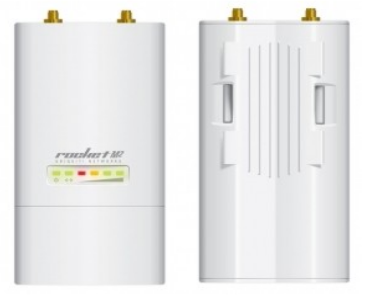
This picture is of 3.4GHz Ubiquiti Rocket M3, this is what currently testing on the 9cm band. Experiments with the 5.8GHz Ubiquiti Rocket M5 within a 20MHz channel I got data through puts up to 35Mb/s more then enough through put for a whole DVB multiplex.
This is a layout of my home DATV setup, I moved away fixed hardware configurations and gone with IP switching. By working with the IP layer this has provided me a lot flexibility that you would not get with hardware. Any configuration change can done at click of a mouse or can be automated.
This is a layout of my home DATV setup, I moved away fixed hardware configurations and gone with IP switching. By working with the IP layer this has provided me a lot flexibility that you would not get with hardware. Any configuration change can done at click of a mouse or can be automated.
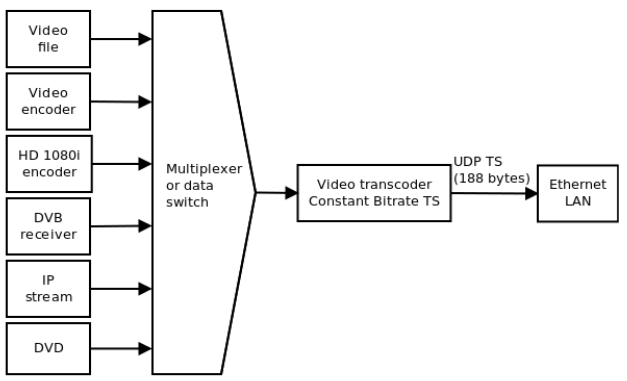
The data pipe, there is no longer a need for analog video this has been taken out of the loop. For example playing a media file, the only loss you would get is in the transcoder stage. This is set by the video bit rate, type of encoder used and quality of this encoder.
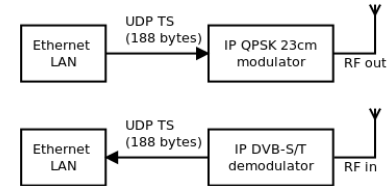
As part of this network you also require IP based QPSK modulator to stream digital video or data to. I have gone with cable TV modulators, they only cost a few hundred dollars these days. I'm also working on software to run on a Raspberry PI, that uses the Ethernet in with the on board output ports to drive a QPSK modulator.

AS for demodulator this nothing more then Hauppauge Nova-S plus PCI card you could just as easily use a HVR-3000 that does DVB-T and DVB-S.
Set top boxes can also be used with DATV such as Sunray 800HD 3 in 1 with it's triple tuner DVB/S/C/T. By replacing it's Linux operating system with open version for this box it will come alive. It can set up as a media center, PVR with addition of a hard drive and the best of all you can IP stream any thing that is being received from the digital tuner.
This set top box has, Mpeg2, h264, AC3, AAC+ decoders built in, in it's hardware chip set. With HDMI video output can view wide range of picture formats up to HD 1080i.
Set top boxes can also be used with DATV such as Sunray 800HD 3 in 1 with it's triple tuner DVB/S/C/T. By replacing it's Linux operating system with open version for this box it will come alive. It can set up as a media center, PVR with addition of a hard drive and the best of all you can IP stream any thing that is being received from the digital tuner.
This set top box has, Mpeg2, h264, AC3, AAC+ decoders built in, in it's hardware chip set. With HDMI video output can view wide range of picture formats up to HD 1080i.
Band layouts:
The 23cm band out of all bands above 1GHz has been the most useful for experimentation. Low enough to do measurements with easy to build test gear. High enough to get good aerial gain with low coaxial loss. Out all these years experimenting with all type of wide band modulation systems, the important thing is a workable band plan and that provides room test these new modulation systems.
The 23cm band out of all bands above 1GHz has been the most useful for experimentation. Low enough to do measurements with easy to build test gear. High enough to get good aerial gain with low coaxial loss. Out all these years experimenting with all type of wide band modulation systems, the important thing is a workable band plan and that provides room test these new modulation systems.
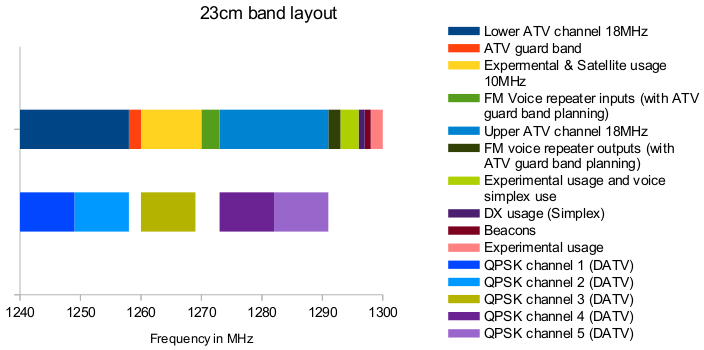
The 13cm band has become a real problem here in Auckland other users. Using standard FM TV and QPSK modulation between 2.4 to 2.45GHz this band is no longer usable. So only way we can use this spectrum to go with spreed spectrum modulation techniques, such as WiFi equipment. The most useful part of this band has been remove (2.3 to 2.396GHz) this has had a big impact on my experimentations!
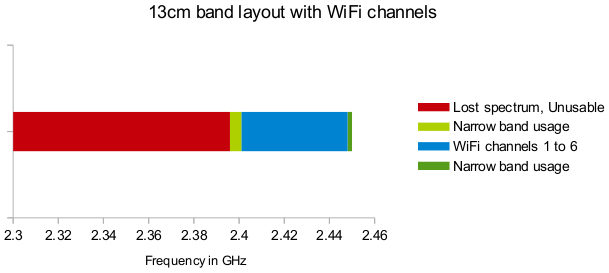
The 9cm band is now where I looking at setting up 30Mb/s data links. By re-flashing the operating software you can shift WiFi equipment down from 3.4 to 3.7GHz to just below 3.4GHz to fit within this band layout. It would be a lot easer if I just program up this equipment within top end of this band, that has been remove from 3.41 to 3.5GHz.
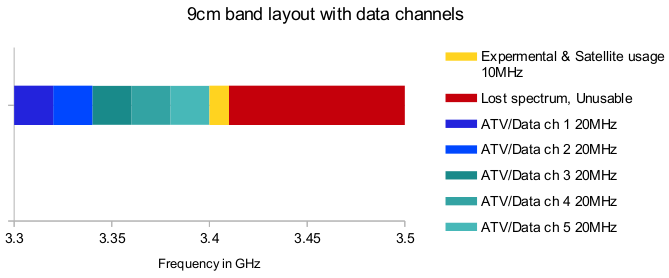
DATV repeater configurations:
They two types of DATV repeaters layouts. One is standard QPSK receiver connected to a DVB modulator this could be COFDM (DVB-T/T2) or QPSK/8PSK (DVB-S/S2).
The other is IP based using 9 or 5cm bands, this can be both input and output within the same data channel. This controlled by remotely setting the IP to ASI media converter for data sending, receiving or both. Another advantage with configuration is inter repeater linking by sending or receiving DVB transport stream via the Internet.
They two types of DATV repeaters layouts. One is standard QPSK receiver connected to a DVB modulator this could be COFDM (DVB-T/T2) or QPSK/8PSK (DVB-S/S2).
The other is IP based using 9 or 5cm bands, this can be both input and output within the same data channel. This controlled by remotely setting the IP to ASI media converter for data sending, receiving or both. Another advantage with configuration is inter repeater linking by sending or receiving DVB transport stream via the Internet.
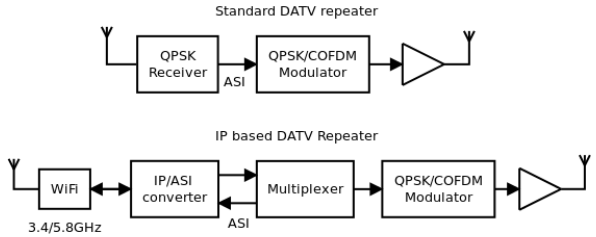
Requirements for a DATV data repeater:
Must be:
1/ Hardware based
2/ Upgradeable
3/ Compatible with IP interfacing and streaming
4/ Access controlled
5/ Able to support both analog and digital inputs
Equipment:
Like my home set up a repeater needs to operate at this data layer and be able to integrate with a Mesh data network. This is where the high speed data pipe come into play using the Ubiquiti Rocket M3 as the 3.4GHz IP port. The plan is to construct two waveguide slot aerials and feed each from the two SMA sockets at top of the Rocket M3 units.
The Auckland repeater hardware is combination home built and cable TV models. Technology move ahead at fast pace these days, as little as 10 years ago there was only SR-systems boards available. Now days with changing requirements for IP linking between repeaters and wide band data transmissions a modern day DATV repeater needs do so much more.
Where by with IP controlled configuration we can remotely log in to the repeater and change the operating parameters like:
1/ Data repeater mode without video been sent
2/ Data and video information to be sent
3/ Video channels only
4/ Video bite rates
5/ QPSK receiver setting such as frequency and symbol rate
6/ Number of channels within the multiplex or multiplex bypass mode
7/ Modulator bate rate
8/ IP streaming on/off
9/ Analog video switching via the Kramer switch
Must be:
1/ Hardware based
2/ Upgradeable
3/ Compatible with IP interfacing and streaming
4/ Access controlled
5/ Able to support both analog and digital inputs
Equipment:
Like my home set up a repeater needs to operate at this data layer and be able to integrate with a Mesh data network. This is where the high speed data pipe come into play using the Ubiquiti Rocket M3 as the 3.4GHz IP port. The plan is to construct two waveguide slot aerials and feed each from the two SMA sockets at top of the Rocket M3 units.
The Auckland repeater hardware is combination home built and cable TV models. Technology move ahead at fast pace these days, as little as 10 years ago there was only SR-systems boards available. Now days with changing requirements for IP linking between repeaters and wide band data transmissions a modern day DATV repeater needs do so much more.
Where by with IP controlled configuration we can remotely log in to the repeater and change the operating parameters like:
1/ Data repeater mode without video been sent
2/ Data and video information to be sent
3/ Video channels only
4/ Video bite rates
5/ QPSK receiver setting such as frequency and symbol rate
6/ Number of channels within the multiplex or multiplex bypass mode
7/ Modulator bate rate
8/ IP streaming on/off
9/ Analog video switching via the Kramer switch
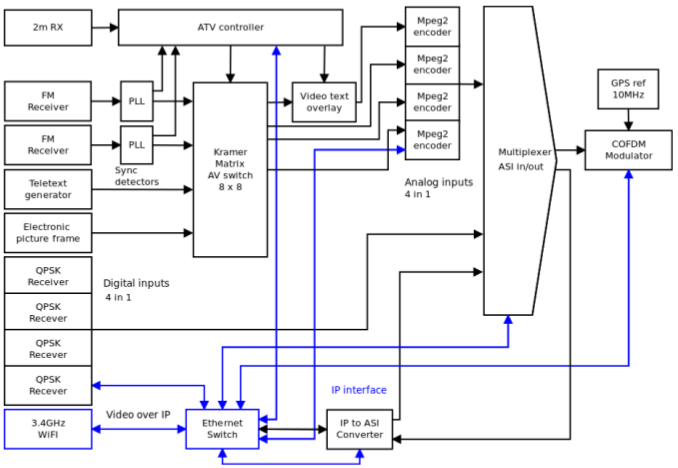
ZL1BQ DATV repeater:
This is a hybrid configuration design to work with both analog FM TV as well as digital inputs.
This is a hybrid configuration design to work with both analog FM TV as well as digital inputs.